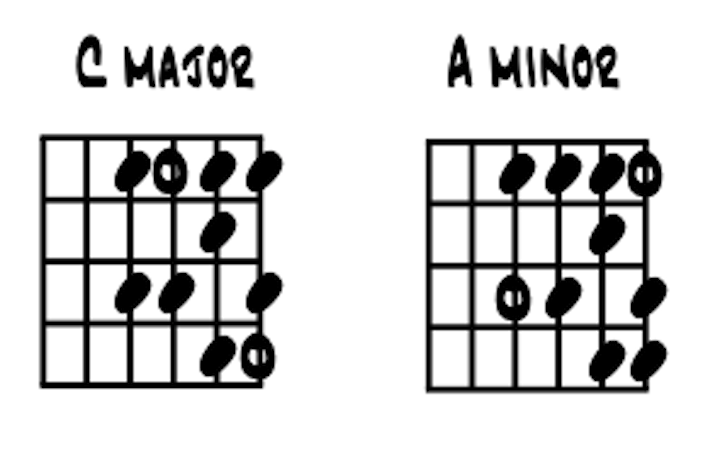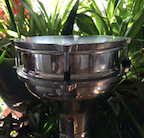|
~ motifs ~ '... bits of melody to suggest, conjure and build upon ~ |
In a nutshell. The following exercises for learning involve having a motif, an idea for a song, and developing it towards that goal; writing the idea into becoming a song. For once we have an idea; a few words, a couple of pitches, a rhythm or groove, we can begin. While we each have our own ways forward once we've an idea, know that over time, and doing this a few times, our methods will probably evolve too, as we get better at our craft and the motifs we find take on a more varied nature. For in truth, we know that an idea for a song can come from just about anywhere any time. For when inspiration strikes ... :) |
A couple of basics. The most common way of developing a motif of course is to simply run the idea over and over. Age old now, this is what happens when a 'tune gets stuck in our head.' so, not a problem for us composers :) Over and over gives the idea a chance to shape itself with how we want it to go. Remember, some songs will write themselves, others will require a lot of attention. And in writing larger works; symphonies, film scores, theme albums, commissions and such, these take time, often weeks and months, years even, to write, polish and present, if that's the goal. |
With lyrics. While some write themselves, just flow off the tongue, most do not. Here we can write down our words and poetry, speak them aloud and find their rhythms. Don't be surprised if there's a pile of rewrites at the completion of a song. For in the process not only does the magic appear, but the strengthening of our skills in the writing process manifest. Just like most things, the more we do it the better we get at the doing :) A secret of Mozart's composing is said to be ... 'just lie on the floor and run the music through the noodle, over and over, and the notes needed will manifest.' Worked for Mozart, has worked for me too though in addition to getting horizontal I'll also jump on the bicycle, or go for a walk, anything really that creates a 'reflective' zone to allow me Muse a way in to solve the current puzzle. |
The motifs. All in 'C' and 'A' minor key centers. And for guitar, located in 5th position with the "Frishelli shape." |
Harmonizing melodies. One of the features of a formal school curriculum is to study in depth how to harmonize the pitches of the melody with supportive chords. For in our composing traditions of the last 500 years or so, flowing melody notes over supportive chords and mostly rhythmically aligned in time has ruled the day and is a pillar of Americana songwriting. Theory termed homophonic music, this composing technique is Euro based and historically follows right along with fine tuning the pitches and building a piano. In learning this magic we can follow the 'theory' rule of diatonic harmony, which gets most of the pieces in place, then jazz it up however from there. The 'style' of a song plays huge in this process too, and helps to shape and mix the colors we choose to glue up together. And there's a couple of basics in determining the 'diatonic harmony of a style.' |
A spectrum of styles and harmony. Crazy to think this way but we're back to our 'numbers of pitches' basis. For we can count up the notes in the chords and see how many we get, then roll through the styles and watch as to get a styles' flavor, we often need to add a pitch or two. Adding the blues hue, all through the American weave of styles and genres, is very common and often requires an extra pitch or so for supporting chords. |
Goes like this. We've 12 total pitches for sure and half a dozen or so broad style categories, add in genres and there's a ton more combinations. Thus, the following left to right visualization emerges. Example 1. |
musical style |
om ~ blues
|
kid's folk blues gospel
bluegrass rock country |
pop
|
adv. jazz |
||||||||
# of pitches |
1 |
2 |
3 |
4 |
5 |
6 |
7 |
8 |
9 |
10 |
11 |
12 |
So in developing a motif into a song, once we've a style and a few pitches, we've the first pieces of the new puzzle and it's development gets under way. |
Spelling the chords. In getting chords with melody pitches, knowing how to spell out the letters of the chords is the great facilitator here. Easily rote learned, here's the magic in chart form. Example 2. |
scale # degrees |
1 |
2 |
3 |
4 |
5 |
6 |
7 |
8 |
C major scale |
C |
D |
E |
F |
G |
A |
B |
C |
arpeggio # degrees |
1 |
3 |
5 |
7 |
9 |
11 |
13 |
15 |
C major arpeggio |
C |
E |
G |
B |
D |
F |
A |
C |
diatonic triads |
CEG |
DFA |
EGB |
FAC |
GBD |
ACE |
BDF |
CEG |
analysis numbers |
I |
ii |
iii |
IV |
V |
vi |
vii |
VIII |
2 octave scale |
C D E F G A B C D E F G A B C |
|||||||
1 3 5 7 9 11 13 1 5 |
C . E . G . B . D . F . A . C |
|||||||
Now with spelling out the letters of each chord in the key of 'C', we gots some options for the pitches of our melody. A lot of this 'bolts right up' of course, then we need to make art out of it as the story tells, then jazz it up if need be. |
What's our melody note ? Staying in the key of 'C', if our song's melody is 'C', then all the three note triads with a 'C' in them will work. Thus: 'C' melody note = CEG, FAC, ACE. 'D' melody note = DFA, GBD, BDF. 'E' melody note = CEG, EGB, ACE. 'F' melody note = FAC, DFA, BDF. 'G' melody note = GBD, EGB, CEG. 'A' melody note = ACE, FAC, DFA. 'B' melody note = BDF, GBD, EGB. Cool ? |
Which to choose? Next we get to decide which chord has the right mojo for the melody note chosen. In these choices its mostly about the story of the song. If we add in a song's bass line story melody notes with the melody / lyrics melody note, chances are we'll get a puzzle piece or two to gets things started off. Combine these two melodies and voila ... chord progressions. :) with the melody, then. Thinking in 'C' major ... soprano melody notes: C E G A G solid chords are CEG and FAC ' C ' bass melody notes or in the key of 'A' minor soprano melody notes: C E G A C solid chords are ACE and DFA ' A ' bass melody notes |
Review. Find a lick or two, a bit of a ditty to spark off a song ? Cool. For in lots and lots of everything, it's an idea ... a what if ... that sparks a step on a pathway and a view into a new portal of discovery and invention. |
"The key to the future of the world is finding the optimistic stories and letting them be known." |
wiki ~ Pete Seeger |
References. References for this page's information comes from school, books and the bandstand and made way easier by the folks along the way. |
Find a mentor / e-book / academia Alaska. Always good to have a mentor when learning about things new to us. And with music and its magics, nice to have a friend or two ask questions and collaborate with. Seek and ye shall find. Local high schools, libraries, friends and family, musicians in your home town ... just ask around, someone will know someone who knows someone about music and can help you with your studies in the musical arts. |
|
Always keep in mind that all along life's journey there will be folks to help us and also folks we can help ... for we are not in this endeavor alone :) The now ancient natural truth is that we each are responsible for our own education. Positive answer this always 'to live by' question; 'who is responsible for your education ... ? |
Intensive tutoring. Luckily for musical artists like us, the learning dip of the 'covid years' can vanish quickly with intensive tutoring. For all disciplines; including all the sciences and the 'hands on' trade schools, that with tutoring, learning blossoms to 'catch us up.' In music ? The 'theory' of making musical art is built with just the 12 unique pitches, so easy to master with mentorship. And in 'practice ?' Luckily old school, the foundation that 'all responsibility for self betterment is ours alone.' Which in music, and same for all the arts, means to do what we really love to do ... to make music :) |
 |
"These books, and your capacity to understand them, are just the same in all places. Always bear in mind that your own resolution to succeed, is more important than any other one thing." |
|
Academia references of Alaska. And when you need university level answers to your questions and musings, and especially if you are considering a career in music and looking to continue your formal studies, begin to e-reach out to the Alaska University Music Campus communities and begin a dialogue with some of Alaska's finest resident maestros ! |
|

